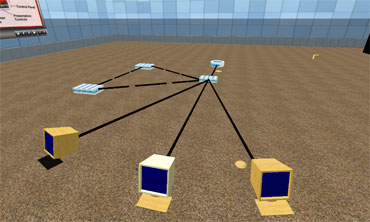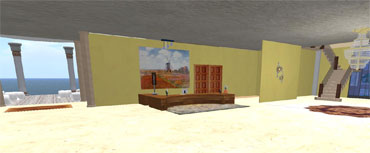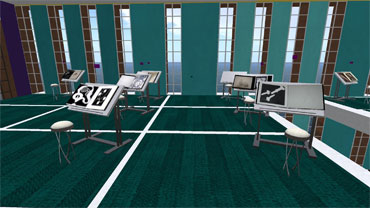Engaging Students in Virtual Learning
In previous articles in this series, an overview of using Second Life for higher education, we saw a surprisingly active community of enthusiasts. We looked at the varying levels of activity on virtual campuses, and we looked at how Elon University incorporates the building and presentation tools of Second Life into class projects. In this installment, we take a look at another active virtual campus--East Carolina University.
A visit to the virtual campus of Greenville, NC-based East Carolina University makes it clear that this is a working campus--walls displaying dozens of renderings and peer review instructions, graphics explaining management principles, and a career services center that leads job seekers to Web pages about improving resumes, long-distance job searching, and stress-free interviewing.
"This semester, we are teaching 10 courses in Second Life," said Sharon Collins, project manager for Academic Outreach Technology Services. Collins manages ECU's Second Life activities. In fact, just before our interview, she was giving a tour to an ECU employee in the health services department, explaining how they might use Second Life to support their efforts.
"We work really hard to help faculty integrate all of this into their programs," said Collins. "When I meet with instructors or other employees, we come up with ideas about how they can use Second Life, and, after that, students often help with their build."
Virtual Classes
Class subjects held in-world include networking, management, interior design, computer science, and law. "We also use Second Life for office hours, career services, undergraduate services, and bookstore information," said Collins. "Our library services department has a good presence in Second Life too."
Some classes, such as interior design, meet on the Greenville campus and in Second Life as well. Others, such as computer science, are part of the distance education program and are taught solely in Second Life, aided with other tools, such as the Web conferencing application Centra.
How do ECU classes use Second Life in the curriculum?
One project in the computer sciences class required the students to create a 3D topology of how the different pieces of a local area network connect to each other.

The hospitality management course is held within a virtual hotel, with a lobby and reception desk, a dining area with tables and table settings, and, upstairs, a corridor with working hotel rooms on either side. Here, they learn to manage the hotel and management.
The interior design students import into Second Life their images of room layout designs.
The designs are then posted on a large gallery wall for all to see. Students give feedback on each others' designs using a note card system--Second Life's interpretation of Notepad-type document--for a highly efficient peer review process. The note cards are contained in the object displaying the designs and are retrievable by the professor and the student.
One interior design project was a day care room. Once on paper, the students built 3D virtual representations within Second Life, allowing them to do a virtual walkthrough to get a better understanding of how well the room works--how appropriately the rooms are sized, whether the scale is correct, where the design mistakes appear, etc.
Once the projects are reviewed and finalized within Second Life, the students use a CAD program to do the final design. The interior design students also benefit from virtual portfolios, which contain all of their work from the semester in one virtual book that can be viewed by others.
"It was great to see the relation of the room sizes to the sizes of the avatars and the sizes of the furniture," said Collins. "It gave them a good visual if they needed to change something."
Many Hats in Second Life
ECU Associate Professor Elizabeth M. Hodge teaches all of her courses online and taught ECU's first Second Life class in 2007. Her most recent administrative management course used Blackboard course management software for making content available combined with Second Life as the tool for delivering some materials. In Hodge's virtual classroom she has a bookcase where students can access documents like required readings, class lecture materials, tutorials, and assignments. She said using Second Life allows students to experience lessons in a more immersive way and also provides for collaboration and peer reviews.
The midterm project for the administrative management class was based on the book Six Thinking Hats by Edward de Bono, which teaches six different approaches to management problem-solving. Six top hats of different colors represent the different ways to analyze a situation. The students were to apply the principles to a case study of a business that faced a particular challenge. Different case studies, from which the students could choose, were described in graphic images that were uploaded into Second Life, then displayed on a Second Life presentation viewer.
"This method allows students to use 'hats' that represent a certain model of thinking to solve a case," said Hodge. "Teams of two or three students meet in world and try on virtual top hats that trigger a different note card (message), telling the teams which mode of thinking to use to solve the case problem." Putting on a virtual blue hat dictated the students look at the problem via organizational management. A white hat meant they needed to approach it by gathering facts and figures, while a green hat meant thinking creatively, and so forth.
After discussing each approach and coming to consensus on how to implement them, the students submitted a paper and a presentation, delivered in-world, to describe their results. Students also completed in-world peer evaluations on one another's case solutions.
Hodge said her approach to teaching administrative management is to use real-world situations. The final project, for example, required the students to review the presidential candidates' positions, submit a paper outlining those positions, then develop a corresponding presentation slide to be displayed within Second Life. The point of this was to understand how economic influences affect management decisions.
"We looked at how trends in the economy affect how we manage employees, how you do marketing, and how you efficiently develop products. I teach that there is more to management than just the act of managing a person, company, or product. For them, it was an eye-opening and applicable project. They enjoyed that assignment, and it helped them better understand the political process."
Next for Hodge is a class on virtual environments that will expose students to the ways in which one can market a company, produce an event, showcase a product, or teach in a virtual environment.
"I am so excited about this summer," said Hodge. The exciting part--is that she plans to ditch the Second Life classroom-style setting and instead, have the students learn, build and immerse themselves in the course content while learning about the seven wonders of the U.S. In a collaboration with ECU's Academic Outreach, they have created the Washington Monument, the Golden Gate Bridge, the Grand Canyon and the rest. Students will receive lessons in combination with a Second Life survey tool that can deliver personal quizzes to demonstrate their level of understanding. Students will also receive the unique adventure of exploring the seven wonders as they "wind their way through the Grand Canyon on a donkey's back, or take a boat ride through Niagara Falls," she explains. "This is a very different way of delivering education."
Hodge will also lead a teaching methods class this fall. In a unique spin, the course will provide students with the opportunity to collaborate with other students from the University of South Carolina at Columbia. Together, they will analyze and evaluate classroom management styles, development of assessment tools, and the creation of in-world portfolios utilizing Thinc books. Thinc books allow students to upload a series of graphic images to display the entirety of completed assignments.
Enhancing the Student Experience
ECU focuses on delivering a good student experience. For example, many higher learning institutions face difficulties when students first try to adapt to Second Life--learning how to get around and communicate have steep learning curves.
Regions provided by Second Life for that purpose are often populated with far too many loiterers who distract from the process. ECU therefore set up their own orientation area, on their own islands, where students can learn the basics with a minimum of distractions. Also, said Hodge, distance education students tell her that attending classes on a virtual campus built to look and feel like the real thing makes them feel more connected to the university community.
Collins' Academic Outreach Technology Services foots the bills for Hodge and any other ECU educators or departments that want to incorporate Second Life into their work. She said her biggest challenge is conveying the value of the application to staff, so she spends a lot of time demonstrating it, as well as helping instructors convert their courses.
"Many of the faculty who use it have become mentors to others," said Collins. "It isn't for everyone and it's not for all disciplines, but the different ways you can approach a subject are fantastic."
About the Author
Denise Harrison is a freelance writer and editor specializing in technology, specifically in audiovisual and presentation. She also works as a consultant for Second Life projects and is involved with nonprofits and education within the 3D realm. She can be reached here.